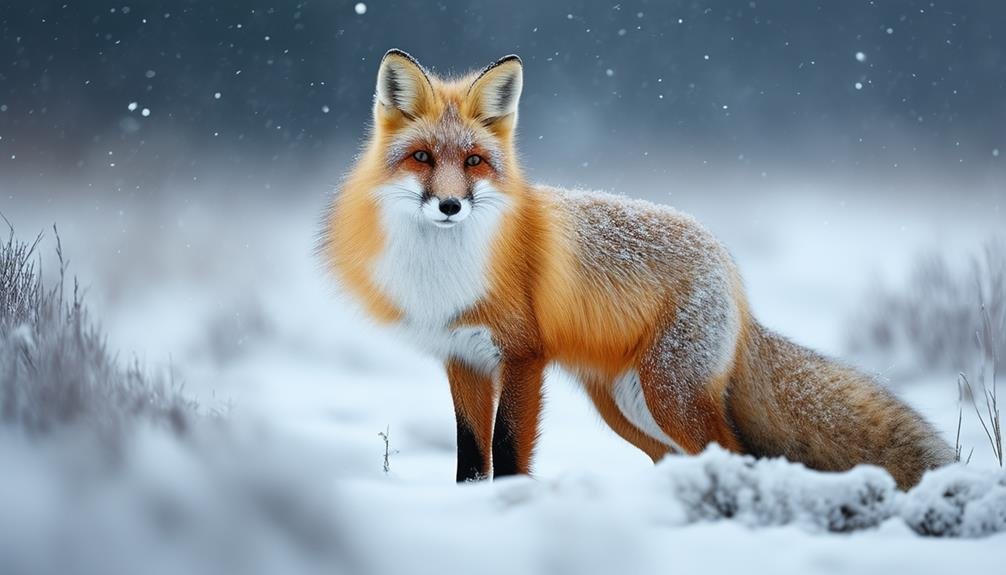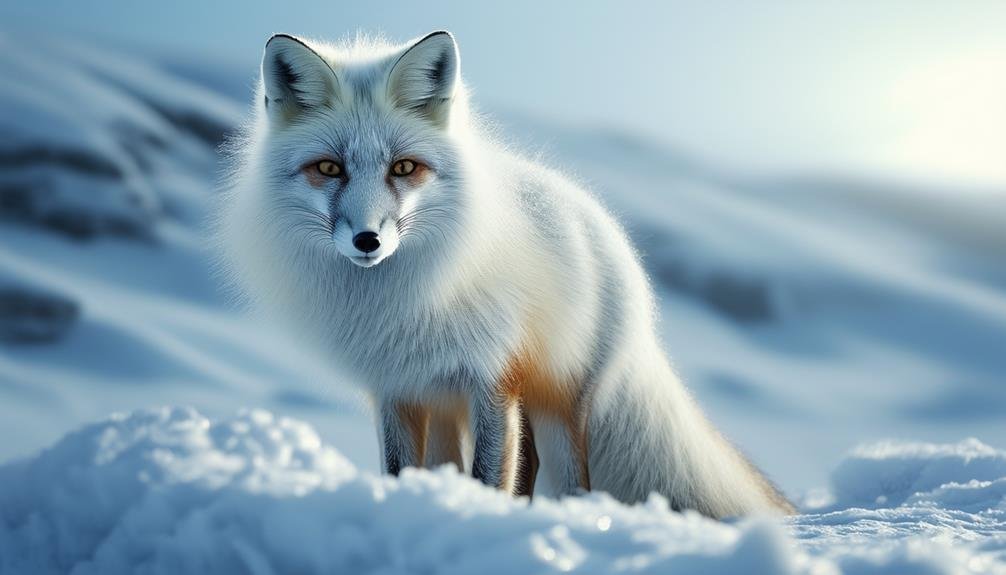Arctic foxes thrive in harsh winters due to a range of specialized adaptations. Their thick fur provides excellent insulation and changes color seasonally for camouflage. Furry paws offer traction and additional warmth. They exhibit behaviors like burrow digging and food caching, which help them secure shelter and sustenance. Their diet is versatile, including small mammals, bird eggs, and scavenged food. Additionally, metabolic adjustments allow them to conserve energy efficiently. These combined physical and behavioral strategies guarantee their survival in extreme conditions. By exploring further, more insights into their remarkable adaptability and the challenges they face will become evident.
Main Points
- Arctic foxes have thick fur coats and bushy tails that provide insulation and warmth during harsh winters.
- They exhibit seasonal fur color changes, offering both camouflage and temperature regulation in different environments.
- Their diet is diverse, including small mammals, bird eggs, insects, and berries, allowing them to exploit various food sources.
- Behavioral strategies like burrow digging and food caching help them secure shelter and sustenance in extreme conditions.
- Metabolic adjustments enable energy conservation, allowing them to survive periods of food scarcity and severe cold.
Physical Adaptations
Arctic foxes possess several physical adaptations that enable them to survive the extreme cold of harsh winters. One of the most remarkable features of Arctic foxes is their thick fur coat, which provides exceptional insulation. This fur can keep them warm in temperatures as low as -58°F. The dense, white coat not only offers protection from the cold but also serves as camouflage, blending seamlessly with the snowy landscape to avoid predators and sneak up on prey.
In addition to their fur, Arctic foxes have furry paws that act like natural snow boots. These padded paws provide both insulation and traction on icy surfaces, allowing the foxes to move efficiently through their frigid habitat. Another crucial adaptation is their bushy tail, which functions as a warm blanket. By wrapping it around their bodies, Arctic foxes can conserve heat and shield themselves from the biting cold.
Furthermore, Arctic foxes possess the ability to slow down their metabolism and heart rate during extreme winter conditions. This physiological adaptation helps them conserve energy when food is scarce, ensuring their body sustains its essential functions even in the harshest environments. These physical adaptations collectively enable Arctic foxes to thrive in some of the planet's most unforgiving climates.
Behavioral Strategies
In addition to their physical adaptations, arctic foxes employ a variety of behavioral strategies to withstand the harsh winter conditions. These strategies are vital for their survival, as they enable the foxes to find food, conserve energy, and protect themselves from the elements.
- Dig Burrows for Shelter: Arctic foxes dig burrows in the snow to create insulated shelters. These burrows offer protection from the extreme cold and harsh winds, providing a safe space for resting and conserving energy.
- Nocturnal Hunting and Caching Food: Arctic foxes exhibit nocturnal hunting behaviors, which help them avoid the coldest parts of the day. They also engage in caching food, storing surplus food when it is abundant, to ensure they have resources during periods of scarcity.
- Territorial Nature and Hibernation: Their territorial nature aids in securing and defending food sources essential for survival. While arctic foxes do not fully hibernate, they reduce their activity levels significantly during the harshest winter months to conserve energy.
These behavioral strategies, combined with their physical adaptations, enable arctic foxes to thrive in one of the planet's most inhospitable environments, guaranteeing their continued survival through the long, harsh winters.
Diet and Hunting

Beyond their behavioral strategies, understanding the diet and hunting techniques of arctic foxes reveals another layer of their adaptability to harsh winter environments. Central to their survival is their versatile diet, which includes lemmings, voles, and other small mammals. These creatures form the primary food sources for arctic foxes, especially during the winter months when availability is limited. The foxes' acute sense of smell and exceptional hearing enable them to locate these prey animals even under thick snow, ensuring a steady food supply.
In addition to small mammals, arctic foxes demonstrate remarkable adaptability by scavenging on bird eggs, insects, and berries. These supplementary food sources become particularly essential when primary prey is scarce. Bird eggs and insects offer protein, while berries provide essential vitamins and minerals, contributing to a balanced diet. Moreover, during periods of extreme scarcity, arctic foxes have been known to scavenge on leftovers from polar bear kills, showcasing their opportunistic feeding behavior.
Camouflage Techniques
The remarkable ability of arctic foxes to blend into their snowy surroundings through seasonal fur color changes is a key adaptation for evading predators and hunting efficiently. This fur color change, from white fur in winter to brown or gray in summer, ensures that arctic foxes maintain effective camouflage throughout the year. This seasonal adaptability enhances their ability to remain undetected in various environments, thus contributing to their hunting success.
Arctic foxes possess several other adaptations that aid in their camouflage and overall survival:
- White Fur: In the winter, their white fur provides excellent camouflage against the snow, making them nearly invisible to both prey and predators.
- Small Ears: Their small ears reduce heat loss and blend seamlessly with their head, contributing to their overall streamlined and inconspicuous appearance in the snowy landscape.
- Muffled Footsteps: The furry soles of their feet muffle their footsteps, making it difficult for prey to detect their approach, improving their hunting efficiency.
In addition to these physical traits, their natural agility and speed allow arctic foxes to navigate the harsh Arctic terrain with ease, further enhancing their ability to capture prey and evade threats. These combined adaptations underscore the remarkable survival strategies of arctic foxes in extreme winter conditions.
Survival Mechanisms

Survival mechanisms of Arctic foxes are remarkable, ensuring their endurance through the harshest winters. The thick fur coat provides exceptional insulation, keeping them warm in extreme cold, while their ability to slow their metabolism conserves energy during times of scarcity. Additionally, their camouflaged white fur and silent movement through the snow enhance their stealth, making it easier to avoid predators and hunt effectively.
Thick Fur Insulation
Arctic foxes possess an exceptionally thick fur coat that serves as a crucial survival mechanism, ensuring their body temperature remains stable in the face of freezing Arctic winters. This dense fur provides excellent insulation, allowing these animals to thrive even in extreme winter temperatures. The thick fur consists of two layers: a dense undercoat and a longer, protective outer layer. This combination is essential for thermal regulation, trapping heat close to the body and preventing the cold from penetrating their skin.
Several key aspects highlight the effectiveness of this adaptation:
- Seasonal Color Change: The fur of Arctic foxes changes from white in winter to brown or gray in summer, aiding in both camouflage and temperature control.
- Fluffy Tail: The fluffy tail acts as an additional blanket, providing extra warmth when the fox curls up during the coldest months.
- Metabolic Adaptation: While the thick fur provides physical insulation, Arctic foxes also adjust their metabolism to conserve energy and maintain warmth.
These highly specialized features allow Arctic foxes to endure some of the harshest conditions on Earth, showcasing nature's remarkable ability to adapt to extreme environments.
Efficient Energy Conservation
In addition to their thick fur insulation, these resilient animals employ sophisticated energy conservation strategies to survive the unforgiving Arctic winters. One of the key mechanisms is the ability to slow down their heart rate and metabolism. By reducing these physiological processes, Arctic foxes minimize energy expenditure, which is essential during times when food is scarce and temperatures plummet.
Another critical survival strategy is their capacity to hibernate for short periods. This form of torpor allows them to conserve energy during extreme weather conditions and periods of food scarcity. When active, the thick fur coat of the Arctic fox provides excellent insulation, trapping body heat and protecting them from the freezing environment.
Moreover, the fluffy tail of the Arctic fox serves a dual purpose. Not only does it aid in balance and communication, but it also acts as a warm blanket when the fox curls up to rest. By wrapping their tails around their bodies, they guarantee additional warmth during the coldest nights.
These energy conservation mechanisms, coupled with their natural insulation, enable Arctic foxes to thrive in the challenging conditions of the Arctic winter, securing their survival amidst one of the harshest climates on Earth.
Camouflage and Stealth
Adaptation to the Arctic environment through camouflage and stealth is essential for the survival of Arctic foxes. Their white fur provides a striking example of natural camouflage, blending seamlessly with the snowy surroundings. This adaptation not only helps them evade predators such as polar bears and wolves but also enhances their hunting efficiency by allowing them to approach prey undetected.
Another critical aspect of their survival strategy is their ability to move silently. The furry paws of Arctic foxes help muffle their footsteps, contributing to their stealth. This silent movement is indispensable when hunting small mammals like lemmings or when avoiding detection by larger predators.
Additionally, Arctic foxes utilize their bushy tails for multiple survival purposes. These tails offer warmth and serve as a shield, enabling the foxes to huddle and hide during extreme weather conditions. This multifunctional use of their tails further underlines their adaptability to harsh Arctic winters.
Key survival mechanisms include:
- Camouflage: White fur blends with snowy surroundings.
- Stealth: Silent movement through furry paws.
- Bushy Tails: Provide warmth and act as a shield.
These adaptations illustrate the remarkable ways Arctic foxes thrive in one of the planet's most unforgiving environments.
How Do Arctic Foxes’ Adaptations to Harsh Winters Help Maintain the Arctic Ecosystem?
Arctic foxes have thick fur and a compact body shape, helping them survive cold winters. Their scavenging habits help reduce waste by cleaning up carcasses, which supports nutrient cycling. The importance of arctic foxes lies in their role as both predator and scavenger, helping maintain balance in the fragile Arctic ecosystem.
Threats and Conservation
Facing numerous threats from human activities and environmental changes, the Arctic fox population is in urgent need of effective conservation measures. Arctic foxes are particularly vulnerable to hunting and fur farms, where hundreds of thousands are bred and killed annually for their pelts. Additionally, the impacts of climate change pose significant challenges, as the loss of permafrost and sea ice drastically alters their habitats. These environmental shifts not only impact their living conditions but also their food sources.
Competition from larger red foxes, which are moving northward due to warming temperatures, further worsens the plight of Arctic foxes. The red foxes outcompete them for food and can even prey on them, adding extra pressure on an already strained population.
Conservation efforts must focus on mitigating these threats through strict regulation of hunting and fur farming practices. Protecting critical habitats and addressing the broader implications of climate change are essential for the long-term survival of Arctic foxes. Collaborative international efforts are necessary to implement effective strategies, such as establishing protected areas and promoting sustainable practices. By addressing these key issues, we can help preserve the delicate Arctic ecosystem and secure the future of Arctic foxes.
Conclusion
Arctic foxes thrive in harsh winters due to a combination of physical adaptations, such as dense fur and compact body structure, and behavioral strategies including burrowing and social hunting. Their diverse diet, effective camouflage, and various survival mechanisms further enhance their resilience. Despite these advantages, arctic foxes face threats from climate change and human activities, necessitating focused conservation efforts. Understanding these factors is vital for ensuring the species' continued survival in extreme environments.


